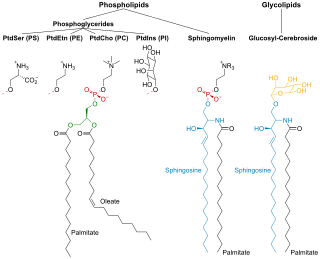Related Research Articles

A lysosome is a membrane-bound organelle found in many animal cells. They are spherical vesicles that contain hydrolytic enzymes that can break down many kinds of biomolecules. A lysosome has a specific composition, of both its membrane proteins, and its lumenal proteins. The lumen's pH (~4.5–5.0) is optimal for the enzymes involved in hydrolysis, analogous to the activity of the stomach. Besides degradation of polymers, the lysosome is involved in various cell processes, including secretion, plasma membrane repair, apoptosis, cell signaling, and energy metabolism.

Benzatropine (INN), known as benztropine in the United States and Japan, is a medication used to treat movement disorders like parkinsonism and dystonia, as well as extrapyramidal side effects of antipsychotics, including akathisia. It is not useful for tardive dyskinesia. It is taken by mouth or by injection into a vein or muscle. Benefits are seen within two hours and last for up to ten hours.

Sphingolipids are a class of lipids containing a backbone of sphingoid bases, which are a set of aliphatic amino alcohols that includes sphingosine. They were discovered in brain extracts in the 1870s and were named after the mythological sphinx because of their enigmatic nature. These compounds play important roles in signal transduction and cell recognition. Sphingolipidoses, or disorders of sphingolipid metabolism, have particular impact on neural tissue. A sphingolipid with a terminal hydroxyl group is a ceramide. Other common groups bonded to the terminal oxygen atom include phosphocholine, yielding a sphingomyelin, and various sugar monomers or dimers, yielding cerebrosides and globosides, respectively. Cerebrosides and globosides are collectively known as glycosphingolipids.

Sphingomyelin is a type of sphingolipid found in animal cell membranes, especially in the membranous myelin sheath that surrounds some nerve cell axons. It usually consists of phosphocholine and ceramide, or a phosphoethanolamine head group; therefore, sphingomyelins can also be classified as sphingophospholipids. In humans, SPH represents ~85% of all sphingolipids, and typically make up 10–20 mol % of plasma membrane lipids.

Clemastine, also known as meclastin, is a first-generation H1 histamine antagonist (antihistamine) with anticholinergic properties (drying) and sedative side effects. Like all first-generation antihistamines, it is sedating.

Ceramides are a family of waxy lipid molecules. A ceramide is composed of sphingosine and a fatty acid joined by an amide bond. Ceramides are found in high concentrations within the cell membrane of eukaryotic cells, since they are component lipids that make up sphingomyelin, one of the major lipids in the lipid bilayer. Contrary to previous assumptions that ceramides and other sphingolipids found in cell membrane were purely supporting structural elements, ceramide can participate in a variety of cellular signaling: examples include regulating differentiation, proliferation, and programmed cell death (PCD) of cells.

Chlorprothixene, sold under the brand name Truxal among others, is a typical antipsychotic of the thioxanthene group.

Clofazimine, sold under the brand name Lamprene, is a medication used together with rifampicin and dapsone to treat leprosy. It is specifically used for multibacillary (MB) leprosy and erythema nodosum leprosum. Evidence is insufficient to support its use in other conditions though a retrospective study found it 95% effective in the treatment of Mycobacterium avium complex (MAC) when administered with a macrolide and ethambutol, as well as the drugs amikacin and clarithromycin. However, in the United States, clofazimine is considered an orphan drug, is unavailable in pharmacies, and its use in the treatment of MAC is overseen by the Food and Drug Administration. It is taken orally.

Biperiden, sold under the brand name Akineton among others, is a medication used to treat Parkinson disease and certain drug-induced movement disorders. It is not recommended for tardive dyskinesias. It is taken by mouth, injection into a vein, or muscle.

Lipid signaling, broadly defined, refers to any biological signaling event involving a lipid messenger that binds a protein target, such as a receptor, kinase or phosphatase, which in turn mediate the effects of these lipids on specific cellular responses. Lipid signaling is thought to be qualitatively different from other classical signaling paradigms because lipids can freely diffuse through membranes. One consequence of this is that lipid messengers cannot be stored in vesicles prior to release and so are often biosynthesized "on demand" at their intended site of action. As such, many lipid signaling molecules cannot circulate freely in solution but, rather, exist bound to special carrier proteins in serum.

Sphingomyelin phosphodiesterase is a hydrolase enzyme that is involved in sphingolipid metabolism reactions. SMase is a member of the DNase I superfamily of enzymes and is responsible for breaking sphingomyelin (SM) down into phosphocholine and ceramide. The activation of SMase has been suggested as a major route for the production of ceramide in response to cellular stresses.

Membrane lipids are a group of compounds which form the lipid bilayer of the cell membrane. The three major classes of membrane lipids are phospholipids, glycolipids, and cholesterol. Lipids are amphiphilic: they have one end that is soluble in water ('polar') and an ending that is soluble in fat ('nonpolar'). By forming a double layer with the polar ends pointing outwards and the nonpolar ends pointing inwards membrane lipids can form a 'lipid bilayer' which keeps the watery interior of the cell separate from the watery exterior. The arrangements of lipids and various proteins, acting as receptors and channel pores in the membrane, control the entry and exit of other molecules and ions as part of the cell's metabolism. In order to perform physiological functions, membrane proteins are facilitated to rotate and diffuse laterally in two dimensional expanse of lipid bilayer by the presence of a shell of lipids closely attached to protein surface, called annular lipid shell.
Ceramidase is an enzyme which cleaves fatty acids from ceramide, producing sphingosine (SPH) which in turn is phosphorylated by a sphingosine kinase to form sphingosine-1-phosphate (S1P).
In enzymology, a ceramide kinase, also abbreviated as CERK, is an enzyme that catalyzes the chemical reaction:

Sphingomyelin phosphodiesterase 1 (SMPD1), also known as acid sphingomyelinase (ASM), is an enzyme that in humans is encoded by the SMPD1 gene.

Ectonucleotide pyrophosphatase/phosphodiesterase family member 7 also known as alkaline sphingomyelin phosphodiesterase (Alk-SMase) or intestinal alkaline sphingomyelinase is an enzyme that in humans is encoded by the ENPP7 gene.
Niemann–Pick disease, SMPD1-associated refers to two different types of Niemann–Pick disease which are associated with the SMPD1 gene.
Acid sphingomyelinase is one of the enzymes that make up the sphingomyelinase (SMase) family, responsible for catalyzing the breakdown of sphingomyelin to ceramide and phosphorylcholine. They are organized into alkaline, neutral, and acidic SMase depending on the pH in which their enzymatic activity is optimal. Acid Sphingomyelinases (aSMases) enzymatic activity can be influenced by drugs, lipids, cations, pH, redox and other proteins in the environment. Specifically aSMases have been shown to have increased enzymatic activity in lysobisphosphatidic acid (LBPA) or phosphatidylinositol (PI) enriched environments, and inhibited activity when phosphorylated derivatives of PI are present.
Ceramide synthase 5 (CerS5) is the enzyme encoded in humans by the CERS5 gene.

Johannes Kornhuber is a German psychiatrist and psychotherapist.
References
- 1 2 3 Kornhuber J, Tripal P, Reichel M, Mühle C, Rhein C, Muehlbacher M, Groemer TW, Gulbins E (2010). "Functional Inhibitors of Acid Sphingomyelinase (FIASMAs): a novel pharmacological group of drugs with broad clinical applications". Cell Physiol Biochem. 26 (1): 9–20. doi:10.1159/000315101. PMID 20502000.
- ↑ Kölzer M, Werth N, Sandhoff K (2004). "Interactions of acid sphingomyelinase and lipid bilayers in the presence of the tricyclic antidepressant desipramine". FEBS Letters. 559 (1): 96–98. doi:10.1016/S0014-5793(04)00033-X. PMID 14960314. S2CID 23974373.
- ↑ Sakuragawa N, Sakuragawa M, Kuwabara T, Pentchev PG, Barranger JA, Brady RO (1977). "Niemann-Pick disease experimental model: sphingomyelinase reduction induced by AY-9944". Science. 196 (4287): 317–319. Bibcode:1977Sci...196..317S. doi:10.1126/science.66749. PMID 66749.
- ↑ Kornhuber J, Tripal P, Reichel M, Terfloth L, Bleich S, Wiltfang J, Gulbins E (2008). "Identification of new functional inhibitors of acid sphingomyelinase using a structure-property-activity relation model". J Med Chem. 51 (2): 219–237. CiteSeerX 10.1.1.324.8854 . doi:10.1021/jm070524a. PMID 18027916.
- ↑ Inhibitors of Secretory Acid Sphingomyelinase (S-ASM): qHTS https://pubchem.ncbi.nlm.nih.gov/assay/assay.cgi?aid=504937
- 1 2 3 4 5 Kornhuber J, Muehlbacher M, Trapp S, Pechmann S, Friedl A, Reichel M, Mühle C, Terfloth L, Groemer T, Spitzer G, Liedl K, Gulbins E, Tripal P (2011). "Identification of novel functional inhibitors of acid sphingomyelinase". PLOS ONE. 6 (8): e23852. Bibcode:2011PLoSO...623852K. doi: 10.1371/journal.pone.0023852 . PMC 3166082 . PMID 21909365.
- ↑ Kornhuber J, Medlin A, Bleich S, Jendrossek V, Henkel A, Wiltfang J, Gulbins E (2010). "High activity of acid sphingomyelinase in major depression". J Neural Transm. 112 (11): 1583–1590. doi:10.1007/s00702-005-0374-5. PMID 16245071. S2CID 27972954.
- ↑ Teichgräber V, Ulrich M, Endlich N, Riethmüller Wilker JB, de Oliveira-Munding CC, van Heeckeren AM, Barr ML, von Kürthy G, Schmid KW, et al. (2008). "Ceramide accumulation mediates inflammation, cell death and infection susceptibility in cystic fibrosis" (PDF). Nat Med. 14 (4): 382–391. doi:10.1038/nm1748. PMID 18376404. S2CID 13251584.
- ↑ Becker KA, Riethmüller J, Lüth A, Döring G, Kleuser B, Gulbins E (2010). "Acid sphingomyelinase inhibitors normalize pulmonary ceramide and inflammation in cystic fibrosis". Am J Respir Cell Mol Biol. 42 (6): 716–724. doi:10.1165/rcmb.2009-0174OC. PMID 19635928.